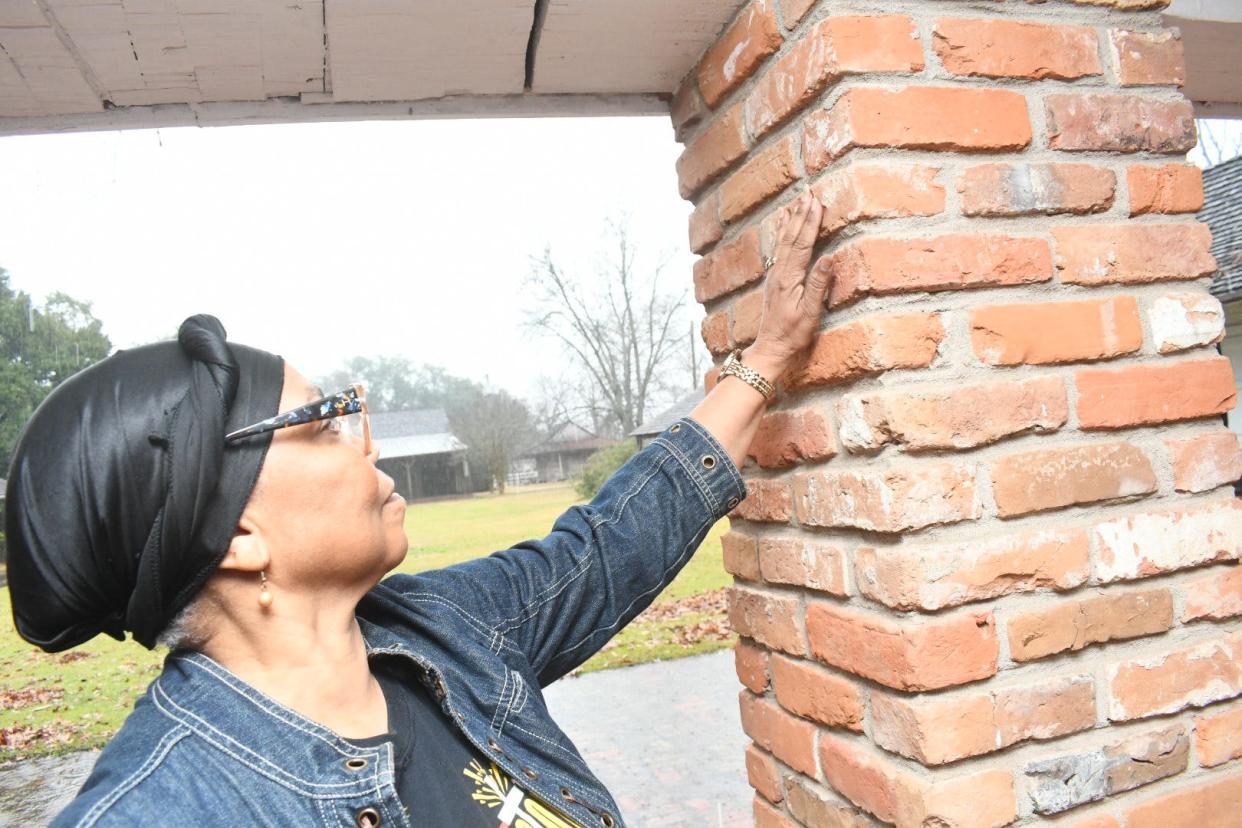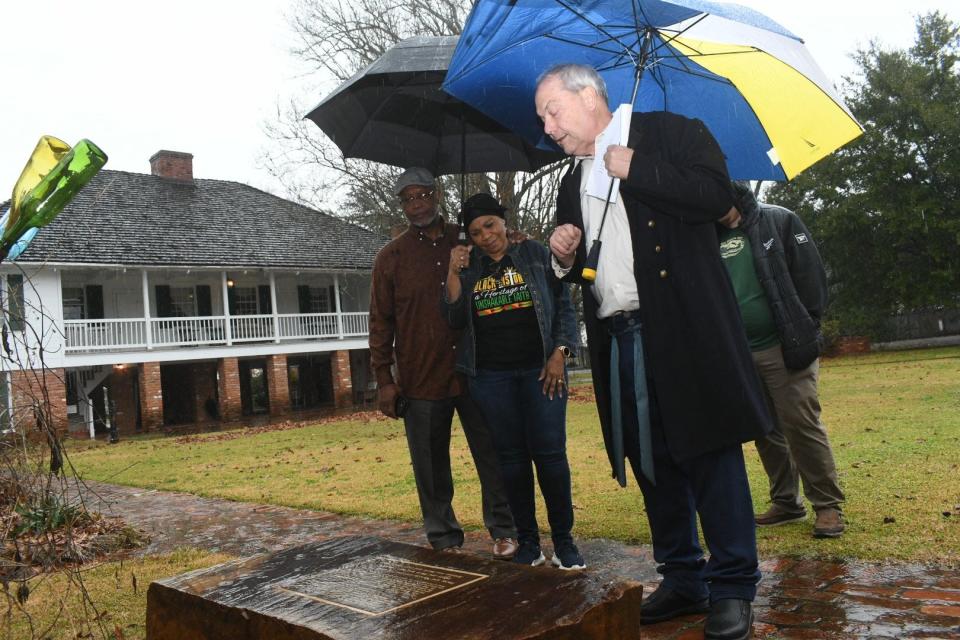Kent House's tour lets visitors walk the path of Central Louisiana's enslaved people

Placing her fingertips on the ones embedded in the handmade bricks at the historic Kent Plantation House, Shelia Draper felt a connection with the unknown enslaved person who made them well over 200 years ago. For her and husband Leslie Draper, this was the most moving part of Kent House’s Black History Month tour, “The Enslaved Experience in Cenla: Living in Bondage.”
This tour specifically focuses on the daily lives of the enslaved, said Alice Scarborough, executive director of Kent House. A candlelight tour will be held at 6 p.m. Saturday (Feb. 10). The other Saturday tours on the enslaved will be at 1 p.m. Prices are $12 for adults, $10 for seniors ages 65 and up, military and AAA members, $4 children ages 6-12 and free for children under 6. Regular tours will also be held. Call (318)487-5998 for tour information.
It was the enslaved people of Central Louisiana who built this Creole plantation house, said local historian Michael Wynne.
Many times the only story that is told of historic plantations, such as those that are in movies, is that of the rich planter families, he said.
“But most of the population of our plantation homes was not the rich white family, It was of the enslaved people,” he said.
“When Pierre Baillio Sr. built this house from 1797 to approximately 1800, he had 80-82 slaves. By 1859, shortly before the Civil War began, Robert Hynson, who then owned the house, had 120-122 enslaved people,” said Wynne, adding that Hynson was the 31st largest slaveowner in the state.
While doing research, he found some interesting statistics about the area now known as Rapides Parish.
“The Rapides area had the highest number of enslaved people than any other area in the state,” he said.
Wynne also found that Louisiana was at the extremes when it came to the populations of enslaved people and free people of color.
“Louisiana had the largest population of free men of color of any state that existed in the early 1800s. And, Louisiana had also the most enslaved people of any state in the Confederacy. So Louisiana is an extreme example of lots of facets regarding race relations,” he said.
The average household had about 5-10 enslaved people. There were enslaved people working in personal houses in downtown New Orleans and in stores, he said.

Sheila thought about the fingerprints on the bricks. Did the enslaved person knowingly do it? Or did it happen as they were placing the bricks to make the pier?
“It kind of made me wonder, what was this person thinking? How was that person feeling? What was the atmosphere like for them,” she said.
Sheila found the tour enlightening and educational because it put her in connection with people who were enslaved at Kent House. She got a feel for where they lived, what they saw and how they were treated.
“It made me appreciate them even more, that they survived through it, those that did, and appreciate where I am today because of what they went through,” she said.
She found the tour very spiritual and recommends that other Black people take the tour.
"They need to walk the halls of the enslaved people. They need to walk the pathways, the barns, the homes and kind of get a feel, not just from the textbooks, but get a feel of where they were,” she said.
On a rainy Saturday, the Drapers drove all the way from Simmesport for their first visit to Kent House. Sheila has only been to one other plantation house. That was in New Orleans about 20 years ago. It was during a family reunion. Family members wanted to visit one. She wasn’t interested and waited for them outside.
The tour piqued their interest after they heard Wynne talking about it on TV and said that the tour was all inclusive and that everyone, regardless of race, needed to know the experience of the enslaved people. Those words caught their attention.
Leslie Draper is the mayor of Simmesport. Before the tour started, he told Wynne that his ancestors were enslaved by the namesake of the town, Bennet B. Simmes who owned White Hall Plantation. He finds it rather ironic that he, a descendant of the enslaved people who worked at White Hall Plantation, is now the mayor of the town that was named after the slave owner.
“This tour is necessary,” said Leslie at the conclusion of the tour. “And I say that in the vein that it’s humbling. It’s really humbling for us. And my wife, we’ve been together almost all our lives, so I know it’s humbling for us. And it also shows how ungrateful we are. The least we can do is come back on tours like this and pay tribute, say thank you, to remind us. This tour is an ingredient to the recipe of humility.”
Like at all other plantations, the enslaved people were divided into three categories.
"Domestic, which was primarily female enslaved people who worked inside the house for the master’s family,” said Wynne. They did the cleaning, cooking, clothes making, washing, gardening and child raising. What might also surprise some people is that they also did wet nursing, he added.
The females who worked in the house were primarily light-skinned and related to the plantation owner’s family in some way, said Wynne on the tour.
The most valuable female enslaved person was the seamstress who made and repaired clothes for the planter's family, he said. They would also teach the planter’s daughters how to sew.
Wynne also tells visitors that when bringing food into the house from the outside kitchen, the enslaved people had to whistle to prove they didn’t taste any of the food.
And when they washed the planter family’s clothes, they were warned to be careful about scrubbing the clothes too hard and damaging them.
Those who slept in the house slept on mats in the bedrooms to be near the family to do such tasks as empty chamber pots, tend the children and make sure the rooms were warm by stoking the fire.
Then there were the field hands.
“The field hands planted, cleared land, dug ditches, cut and hauled wood, cooked, repaired the buildings and/or tools, spin wool and cotton, and weaved and made clothes for everyone,” said Wynne.
The most valuable of the enslaved people were the artisans who did work such as carpentry, tanning, cobbling, roofing, butchering, brick masons and blacksmithing.

One of the many interesting facts he found out was that on large plantations like Kent House, one enslaved person was assigned to make shingles for the house because shingles often wore out and making them was a full-time job.
"Some of the planters would hire out the artisans, particularly the blacksmiths, which were just the most skilled of all the skilled trades, for as much as $25 a day, which is we we would look at as an astronomical amount,” he said.
Males in their “prime,” meaning ages 15-30 were also seen as valuable, he said. Babies were allowed to stay with their mothers until they were old enough to work.
The least valued of the enslaved were the old and the disabled, said Wynne.
“The ones who could not work,” he added.
Enslaved people made culinary dishes that “changed America,” said Wynne. Foods like jambalaya and gumbo have their orgins in Africa. Okra, a vegetable most associated with the South, was brought over from Africa and planted by the enslaved.
When eating their own food, enslaved people used gourds. They were given limited rations.
A memorial near the slave cabins was dedicated to the enslaved people last year. It only lists a few of the names of some of the enslaved that were found through baptismal records from a Catholic church in Mansura, said Wynne.
Wynne feels that this story is eye-opening and makes him appreciate and understand history better.
“It makes me understand the descendants of the enslaved people, their beliefs and their concerns better,” he said.
“It happened. It’s history. It wasn’t good but we believe that the story has to be told,” said Scarbrough.
This article originally appeared on Alexandria Town Talk: Kent House's tour lets visitors walk the path of Central Louisiana's enslaved people

